Dr Andrew Smye (President’s Award)
The first President’s Award today goes to Dr Andrew Smye of Pennsylvania State University, who unfortunately cannot be with us today.
Andy Smye completed his Masters at Oxford in 2007. A NERC Studentship then took him to Cambridge, to work on the tectono-metamorphic evolution of the Tauern Window eclogites in the Eastern Alps. Significant publications emerged from his thesis.
After a postdoctoral spell at the NERC Isotope Geoscience Laboratories in Keyworth, he moved to the University of Texas at Austin as a Jackson Distinguished Postdoctoral Fellow in the Department of Geological Sciences, pursuing novel approaches to thermochronology, notably Uranium-Lead age depth-profiling of rutile grains.
In 2015 he was awarded a five-year NERC-IRF postdoctoral fellowship in Oxford, but almost immediately won a tenure-track position at Penn State. He is building a research group centred on understanding the thermal and chemical evolution of the continental lithosphere and is an investigator on the NSF-sponsored Ex-Terra Research Program on subduction zones.
Andrew Smye, you combine boundless enthusiasm with the breadth of knowledge more typical of a much more senior researcher. Please receive the first President’s Award with our congratulations.
Dr Martin Hurst (President’s Award)
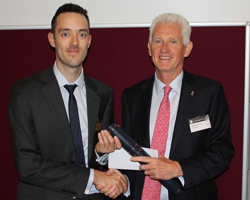
The second President’s Award goes to Dr Martin Hurst of the University of Glasgow.
Martin Hurst studied for his BSc and PhD at Edinburgh. His PhD was awarded in 2013, and following four years at BGS, he joined Glasgow’s School of Geographical and Earth Sciences as a lecturer in 2016. Over this time Martin has developed an international profile in three areas: analysing Earth surface topography using novel techniques, to reveal hillslope response to tectonic forcing; using cosmogenic isotopes to understand erosional history on rocky coastlines; and numerical modelling of coastal evolution.
Martin’s publication record is already exceptional. Highlights of his work include a first-author paper in Science based on his PhD, and a first-author paper in PNAS on recession of the chalk cliffs of southern England, based on BGS work. His first paper, in the Journal of Geophysical Research, gained an impressive 59 citations. He has also won considerable funding, contributing to three NERC grants to a total of £750k, the most recent as Principal Investigator.
Dr Martin Hurst you are a most worthy recipient of our second President’s Award.
Dr Richard Walters (William Smith Fund)
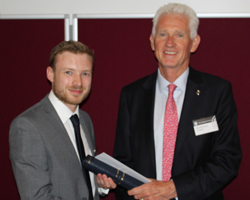 The William Smith Fund goes to Dr Richard Walters of Durham University.
The William Smith Fund goes to Dr Richard Walters of Durham University.
Richard graduated from Oxford in 2008, and received his DPhil in 2012. He then moved to Leeds as a Postdoc, and was appointed Assistant Professor at Durham University last year.
Richard applies geodetic tools (principally InSAR and GPS) to understanding the earthquake cycle, and how the Earth’s crust deforms both in response to earthquakes and long-term stresses. He has conducted forensic studies of major earthquakes from Central Asia to California, locating the responsible faults, and understanding how they slip at depth.
This is important for hazard assessment, and Richard has demonstrated a keen awareness of the importance of communicating with a broader audience; his research and expert opinion has been regularly featured in the national and international press, and he has written several articles for The Times.
Richard also uses geodesy to probe the rheology of the lithosphere and crust. To do this he measures post-seismic motions, and has added numerical modelling to his armoury of skills.
Richard Walters, you combine the talents of a geologist with the analytical approach of a geophysicist. Please accept with our compliments the William Smith Fund of the Geological Society of London.
Dr Sami Mikhail (Murchison Fund)
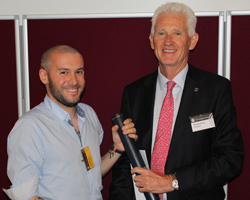 The Murchison Fund of the Society is awarded to Dr Sami Mikhail of the University of St Andrews.
The Murchison Fund of the Society is awarded to Dr Sami Mikhail of the University of St Andrews.
Sami Mikhail began his PhD at UCL in January 2008. Since then, Sami has published 14 papers in high impact journals, on various aspects of cosmogeochemistry and volatile cycling. Of his many academic achievements, one that attracted media interest was his 2014 Nature Geoscience paper with Dimitri Sverjensky, which suggested that the Earth’s nitrogen-rich atmosphere was the result of plate tectonics and subduction, which oxidised portions of the upper mantle, converting ammonium to nitrogen that then outgassed through arc volcanoes.
Sami has also published on carbon isotopic fractionation between diamonds and iron carbide, suggesting that isotopically light regions of mantle might exist beneath cratons; and on the variability of carbon and nitrogen isotope compositions of diamonds.
Sami is now extending his research to other planets, including the effect of thermal regime on the strength of the Martian lithosphere, and the role of plate tectonics in producing oceans on Earth, compared to Venus.
Sami’s collaborators are an international Who’s Who of high temperature geochemistry. His international reputation is growing, leading to regular invited talks at Goldschmidt and AGU.
Sami Mikhail, we are delighted to award you today the Murchison Fund of The Geological Society of London.
Dr Susannah Maidment (Lyell Fund)
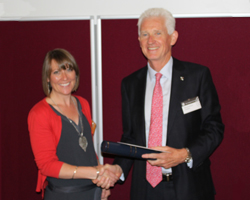 The Lyell Fund of the Society is awarded this year to Dr Susannah Maidment of the University of Brighton.
The Lyell Fund of the Society is awarded this year to Dr Susannah Maidment of the University of Brighton.
Susie is an outstanding palaeontologist who has already made several substantial research contributions in her career. She completed her PhD at Cambridge on the systematics of stegosaurian dinosaurs, setting the tone for her subsequent work. She has since published nearly 30 highly-cited papers, in leading international journals. Susie is now the world’s foremost authority on stegosaurs and has been invited to write the Stegosauria chapter for the third edition of The Dinosauria.
Susie has also analysed the musculature, locomotion and functional morphology of quadrupedal dinosaurs, applying biomechanical and anatomical techniques to understand their postural and anatomical changes during the evolutionary shift from bi- to quadrupedality.
She is now even able to assess the stegosaurs’ biodiversity gradient from equator to pole, using the Late Jurassic Morrison Formation of the western USA as a test case. Her work has already greatly refined the correlation of this intensively sampled Formation.
Recently, Susie has also been involved in exciting work on soft-tissue preservation. Her co-discovery of collagen fibres and red blood cells in 75 million-year-old specimens that are not ‘exceptionally preserved ‘is potentially paradigm-shifting.
Susannah Maidment, please accept, with our congratulations, the Lyell Fund of The Geological Society of London.
Dr Russell Garwood (Wollaston Fund)
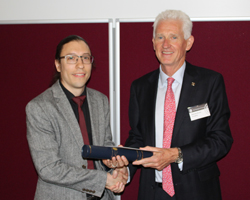 The Wollaston Fund of the Society is awarded this year to Dr Russell Garwood of the University of Manchester.
The Wollaston Fund of the Society is awarded this year to Dr Russell Garwood of the University of Manchester.
Russell graduated from Imperial College, London, in 2007. He went on to do a PhD there, and has since worked at the Natural History Museum, then at the University of Manchester, where he is now lecturer.
His work makes use of computed tomography and digital 3D reconstruction, in which applications he has established himself as an expert. He published his first paper in the second year of his PhD, and now has over 30 peer-reviewed articles and a textbook on 3D techniques to his name.
His early work showed how these approaches could be used to study early land animals - in particular insects and arachnids. Russell revealed important elements of their anatomy, informing work on the evolutionary relationships, palaeobiology and locomotion of arachnids, and probing such questions as the origin of insect wings.
He has since worked on a broad range of topics, including the interplay between evolution and ecology, animal development in both the fossil record and living groups and - with a masters student - the petrological context of the earliest putative fossils through CT and confocal microscopy.
Russell Garwood, in recognition of these achievements your much-admired commitment to public communication, we are delighted now to award you the Society’s Wollaston Fund for 2017.
Rotunda – The William Smith Museum of Geology (R H Worth Award)
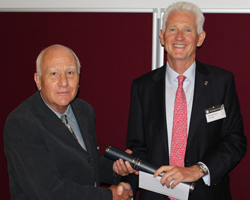 The R H Worth Award celebrates the practice and encouragement of geological science by and among amateurs. This year we are pleased to award it to Rotunda – The William Smith Museum of Geology, Scarborough.
Following his release from debtor’s prison in 1819, William Smith began a new life in the north of England. He first visited Scarborough in 1820 and from 1828 to 1834 worked as land agent to Sir John Johnstone FGS, at nearby Hackness Hall. In 1827 the newly formed Scarborough Philosophical Society decided to build.
The R H Worth Award celebrates the practice and encouragement of geological science by and among amateurs. This year we are pleased to award it to Rotunda – The William Smith Museum of Geology, Scarborough.
Following his release from debtor’s prison in 1819, William Smith began a new life in the north of England. He first visited Scarborough in 1820 and from 1828 to 1834 worked as land agent to Sir John Johnstone FGS, at nearby Hackness Hall. In 1827 the newly formed Scarborough Philosophical Society decided to build.
Opened two years later, the Rotunda was designed, under guidance from Smith, to illustrate his geological principles. Smith acted as Site Manager, and remained associated with it until his death in 1839.
Eventually the building was taken over by Scarborough Borough Council and in 2002 Lord Derwent , Johnstone’s direct descendant, agreed with them that the Rotunda should be returned to geology. Under Lord Derwent’s leadership almost £4.5 million pounds were raised for major restoration and extension. In 2008, it reopened as “Rotunda – the William Smith Museum of Geology” providing a geological museum of national and international historical significance.
Managed by Scarborough Museums Trust, the Rotunda holds extensive collections, especially of local fossils, in a purpose-built store nearby. Its important collection of historic, type, figured and cited fossils is already illustrated online.
The museum plays a leading role in introducing amateurs (and children of all ages) to geology - especially the geology and palaeontology of the Yorkshire Coast, through ‘Dinosaur Coast’ events: including excursions, talks, fossil-handling sessions, open days, school, university and geological group visits. The associated Rotunda Geology Group runs a field and lecture programme involving professional geologists.
In September the Rotunda also hosts the Yorkshire Fossil Festival, in collaboration with co-sponsors the Palaeontological Association.
For these and many more outstanding efforts, I now present, to the Rotunda Museum Scarborough, the R H Worth Award of The Geological Society of London.
Professor Pete Rawson, replying on behalf of the Rotunda Museum, said:
Mr President, ladies and gentlemen, it is a great pleasure to receive this award on behalf of staff, trustees and our army of supporters associated with the Rotunda Museum. My own link started just round the corner from Burlington House, when Lord Derwent invited me to lunch at Boodles – I went in as a professor at UCL and came out as a shadow trustee, thus learning at the tender age of 62 that there is no such thing as a free lunch!
I subsequently retired to Scarborough in 2006 and have worked with the trust ever since, from 2008-2016 as Chairman. It has been very satisfying to see the revitalised Rotunda playing a pivotal role in enabling both young and old to explore the wonders of geology and especially of the beautifully exposed sequences of our Dinosaur Coast. And with the creation of the linked Rotunda Geology Group we have been able to attract a wide range of academic and industrial speakers to further broaden our offer, while the Rotunda and its surrounds provide a beautiful setting for the annual Yorkshire Fossil Festival, which we will be hosting again in September.
We have an ambitious programme planned for the next three years. We are instituting an annual celebration of the Rotunda’s birthday (it opened on 29 August 1829) while in October we will celebrate Earth Science week with the theme “our restless earth”. Then next spring we will open a special exhibition on Jurassic seas. Further ahead, in March 2019 we plan to celebrate the 250th anniversary of William Smith’s birth. Smith is also expected to conduct visitors around the Rotunda during the “Museums at Night” weekend! So we hope that with these and our other dinosaur coast activities we will continue to justify your confidence in making this award. We are very grateful.
Mr Ian Kenyon (Distinguished Service Award)
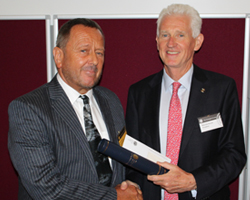 The first Distinguished Service Award goes to Mr Ian Kenyon. Ian joined the Geography and Geology department at Truro School in 1980, becoming Head of Geology in 2009. He is now in his 37th year there - and intends to continue! During that time, the Department has received 11 awards from the Good Schools Guide and has often produced the highest achieving students in the country.
The first Distinguished Service Award goes to Mr Ian Kenyon. Ian joined the Geography and Geology department at Truro School in 1980, becoming Head of Geology in 2009. He is now in his 37th year there - and intends to continue! During that time, the Department has received 11 awards from the Good Schools Guide and has often produced the highest achieving students in the country.
Ian is a member of the Welsh Joint Education Committee which he joined as Principal Examiner in 2000 after a period examining for Edexcel. His work for the Geological Society began when he became involved in developing web-based teaching and learning resources on “The Rock Cycle” and “Plate Tectonics”. For the last four years Ian has been a principal leader in the Society’s Geoscience Education Academy. He has provided and delivered all the teaching resources freely distributed to science and geography teachers attending the course, and which are one of the main reasons for the Academy’s excellent course feedback evaluations.
Recently Ian has accepted a new role as Chief Examiner for the new GCSE specification, which starts this year. He is currently writing resources and the teachers’ guide for GCSE.
For his contributions to school geology at GCSE and A level, and his impact on numbers taking up geology at university - together with his work as an examiner and in supporting the educational aims and remit of the Geological Society – Ian’s service to geology over the 36 years of his career can certainly be classified as ‘distinguished’.
So, Ian Kenyon, in recognition of your unconquerable enthusiasm and dedication, we are delighted to mark our appreciation by awarding you today the Distinguished Service Award of The Geological Society of London.
Mr Ian Kenyon replied:
Thank you Mr President, I am honoured and delighted to receive this award from the Geological Society today. I am especially pleased that a schoolteacher has been recognised as making an important contribution to the wider geological community.
In fact I wouldn't be standing here today if it were not for Mike Edwards, my A level physical geography teacher at Runshaw College in Leyland, Lancashire. In 1975 Mike started Geology as an extra-curricular activity. Lessons at lunchtime and after school with field trips at the weekends.
I did the 'O' level in the Lower Sixth and the 'A' level in the Upper Sixth. Mike Edwards' enthusiasm and expertise led me to study Geology at degree level. He instilled a passion for the subject in me which is stronger than ever today.
Living and teaching in Cornwall I have been lucky to have some of the finest Geology in the world on my doorstep. Consequently I run 19 different trips in Cornwall which are only a 15 - 75 minute drive from Truro School.
I should like to thank the Senior Leadership Team at Truro School who have totally supported my commitment to field-based learning. In fact, they regard Geology as a unique selling point for the school and Geology is the fourth most popular subject at 'A' level after Maths, Biology and Chemistry. At GCSE, Geology is the second most popular option choice after Geography. At any time, there are between 170 and 200 pupils studying Geology at GCSE and 'A' level.
Since starting my teaching career in 1980 over 400 of my students have gone on to complete Geoscience Degrees and have found employment in the industry all over the world. In 2014 my former student Hannah Hughes received the President's Award from then President David Shilston.
I would like to thank my sponsors Pete Loader of the WJEC and Professor Iain Stewart of Plymouth University, two colleagues I hold in the highest professional esteem.
Finally, I would like to thank my partner Jacquie who constantly puts up with my geologising, especially on the numerous summer holidays where we spend more time in disused quarries, abandoned mines and road cuttings than on the beach or by the pool.
This Award means a great deal to me and it is something I will always treasure. Thank you very much.
Dr Richard Hinton (Distinguished Service Award)
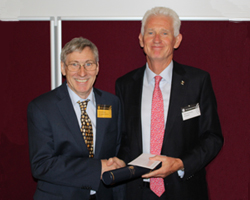 The second Distinguished Service Award goes to Dr Richard Hinton of the University of Edinburgh.
The second Distinguished Service Award goes to Dr Richard Hinton of the University of Edinburgh.
Richard Hinton is an ion probe specialist and a Senior Research Fellow at the University of Edinburgh, who has dedicated most of his career to the provision, support, and continued development of a world-class ion microprobe facility in the UK; namely, the NERC-funded Edinburgh Ion Microprobe Facility or ‘EIMF’.
His early scientific contributions helped to establish applications of secondary ion mass spectrometry to a spectrum of problems – from radiogenic isotope variations and trace-element content of natural zircons, to stable isotope variations in extra-terrestrial materials. His support and training of numerous graduate students and early-career researchers has continued to advance research frontiers across the geosciences.
Richard Hinton has had a distinguished research career, but the aspect of his life work that we honour today is the role he has played in establishing and sustaining a world-class ion microprobe facility over past 29 years as a service to others.
The EIMF was established in 1988, and is recognised for the quality of the training opportunities offered to generations of research students, and for its sustained support of the UK research community over the past 29 years. Richard’s contribution to this has been substantial and significant. Not only did he help set up the facility (from August 1987), but he established the basis for routine analysis of silicate minerals, ran the instruments and continued to develop new techniques and applications.
For almost three decades, the ion probe facility has provided data underpinning over 130 PhD theses, and many hundreds of peer-reviewed papers. The ‘h index’ attributable to papers published from the facility over the past quarter century exceeds 65.
Richard Hinton, in honour of your work on and dedication to the Edinburgh Ion Microprobe Facility, please accept the Distinguished Service Award of the Geological Society of London.
Dr Richard Hinton replied:
I am very pleased to accept this award but am aware that my ‘contribution to the geoscience community’ is as part of the Edinburgh Ion Microprobe Facility team effort provided over the last 30 years by myself and Dr John Craven and also, over the last 8 years, by Dr Cees-Jan de Hoog.
In 1976 Dr Jim Long took a gamble on a non-physicist and together with Dr Stephen Reed introduced me to ion probes and the mysteries of secondary ion mass spectrometry. I never looked back and, apart from a quick flirt with the delights of boiling HF, have been working in this area ever since.
In 1987 NERC awarded its largest-ever grant of £827,000 to Drs Colin Graham and Ben Harte to set up an ion probe laboratory at the University of Edinburgh Department of Geology (now the School of GeoSciences). I believe a grant round was suspended in order to fund this award; not necessarily the best way to make friends around the country. I counted myself very fortunate to get the post to help run the Cameca ims-4f and, together with John Craven, set out to train (and then let loose on the instruments) over 300 students and academics. Over the years this has included 28 Geological Society award winners (or their students), including 9 Presidents’ award winners.
Prof Ben Harte and colleagues later obtained JIF funding and the large radius Cameca ims-1270 was installed in 2003, effectively doubling our workload and heralding a move for me back into U-Pb dating (my passion) and much, much more. PIs have also changed over the years with Prof Simon Harley, Dr John Craven and Prof Rachel Wood, taking up where Ben and Colin left off, in securing continued funding of the EIMF.
My thanks go to NERC and the University of Edinburgh for their continued funding of the EIMF. Also I should like to thank the support from Cameca (in particular Michel Schuhmacher) for without their instruments we could not do the diversity of projects covered by the EIMF. Finally, I should like to thank my wife, Moira, for her support and putting up with the late night call outs and disrupted weekends with so little complaint.
Again thank you for the award which I am honoured to accept.
Professor Mott T Greene (Sue Tyler Friedman Medal)
The Sue Tyler Friedman Medal, awarded for distinguished contributions to the recording of the history of geology, goes this year to Professor Mott T Greene of the University of Washington.
Mott Greene is the author of two, truly landmark books on the History of Geology. The first, Geology in the 19th Century, reopened (at least among English speaking historians of science) work on pre 20th Century tectonics, and more specifically on Eduard Suess and the nappe theory of the Alps. His monumental biography of Alfred Wegener published in 2015, is the first scholarly biography of Wegener and is definitive.
During the long gestation of this seminal work, Greene read everything that he learned Wegener had read, spent a week alone on the Greenland icecap to get a feel for what it is like, and unearthed many letters by Alfred and Else Wegener.
What Greene has done in teasing out Wegener’s changing views on continental drift far surpasses even what Hank Frankel – a previous winner of this medal - wrote on him in The Continental Drift Controversy: Wegener and the Early Debate. Greene also sorts out the different contributions by his father-in-law Vladimir Köppen and Wegener to their book Climates of the Past and shows that Milutin Milankovitch also contributed to the book. Moreover, he nicely explains the importance of paleoclimatology to Wegener’s defence of continental drift.
Greene has an original mind, with the result that all his work is penetratingly authentic and insightful. He gets to the heart of the matter, and is not afraid to argue for an unpopular view - as witnessed by his interpretations of myths in Hesiod’s Theogony in terms of historically recorded massive volcanic explosions.
Mott Greene - for your long-awaited and much anticipated biography of Wegener, and by virtue of your previous works, please accept with our deepest respect and gratitude, the Sue Tyler Friedman Medal of The Geological Society of London.
The President then read out on behalf of Professor Mott Greene, who could not be present for family reasons:
Mr President, I want to thank Ted Nield, Hank Frankel and Ken Taylor for that very generous account of my work in the history of geology, and I am deeply grateful to the Geological of London for naming me the recipient of the Sue Tyler Friedman Medal. I knew Sue and Gerry Friedman, and their commitment to the history of the Earth sciences. I succeeded Gerry as editor of the journal he founded, Earth Sciences History, and continued the work he did to get historians of science to pay attention to subjects other than physics and biology.
When I was an undergraduate at Columbia in the 1960s I took introductory geology from Rhodes Fairbridge. In the fall of ‘64 we did the traditional ‘physical geology’ introductory syllabus, and were supposed, in the Spring of ‘65, to study historical geology and palaeontology. But when Professor Fairbridge strode into the room in the January of 1965, having just returned from London, he announced to us that a good deal of what we had been taught in the fall was wrong and that we should have to start over because - the continents moved! And start over we did, working without a textbook because textbooks did not yet contain portraits of Alfred Wegener, and maps of continental displacements.
I've always associated the revolution in the Earth sciences that took place in the decade that followed with London, because Fairbridge seemed have brought the news directly from there.
At that time I did not know I would end up becoming a chronicler of the prehistory of that revolution, in the global tectonics of the 19th Century, and in the work of Alfred Wegener in the 20th; but my later inspiration to attempt this was certainly the experience of that transformative moment. Scientific revolutions are few and far between, and it is an immensely lucky happenstance for a historian to live through one, and then be able to write about how, when, and where it began.
Once again, my deepest thanks to the Society for the great honour of the Sue Tyler Friedman Medal.
Professor Caroline Lear (Bigsby Medal)
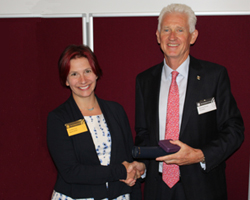 We come now to the Bigsby Medal, which this year is awarded to Professor Caroline Lear of Cardiff University.
We come now to the Bigsby Medal, which this year is awarded to Professor Caroline Lear of Cardiff University.
In the 16 years since completing her PhD, Carrie Lear has become a pre-eminent palaeo-oceanographer, recognised and respected by colleagues in the UK and internationally. Carrie has made significant contributions to reconstructions of Cenozoic palaeoclimate, cryosphere development, and ocean history.
Her first paper, with Harry Elderfield and Paul Wilson, published by Science in 2000, was a landmark contribution, demonstrating an approach to reconstructing Cenozoic ice volume using multiple geochemical proxies from benthic foraminifera. This work continues to be highly cited (over 800, and counting!). Carrie has since gone on to refine these and many other proxies, and to apply them in greater detail across key transitions in the Cenozoic.
Through collaborations with colleagues elsewhere, she has been able to explore the relationship between climate pCO2 and the cryosphere during this era, and GoogleScholar suggests that her papers have so far been cited over 3400 times.
With NERC, NSF and University funding of over three million pounds in research grants, Carrie’s record is outstanding and has led to rapid promotion - culminating in her appointment to the position of Professor in Cardiff University last year.
Carrie has demonstrated leadership in research, training and outreach. She has supervised 15 research students and three PDRAs, is a STEM Ambassador, a frequent interviewee on radio, and has delivered many public and school lectures.
Caroline Lear, your service to geological research and communication is of the highest level.
Please therefore accept today, with our congratulations and confidence in the future, the Bigsby Medal of The Geological Society of London.
Caroline Lear replied:
First of all, I would like to say thank you to the Society, and those who nominated me for this incredible honour.
I was born in a copper-nickel mine hospital in Botswana and I grew up near the Dorset Heritage Coast, so it was perhaps inevitable that I absorbed a passion for geology, from my surroundings and my father, a gifted teacher.
This compelled me to mangle my timetable and somehow squeeze in some geology classes at the local boys’ school.
My geological education continued at Oxford with wonderful tutors, including David Bell and Hugh Jenkyns. Martin Brasier gave the geochemistry lecture that inspired me to apply for a PhD reconstructing seawater chemistry, with Harry Elderfield and Paul Wilson.
As is often the way in research, it was a digression from the project description that led to the most exciting results and started my interest in palaeoclimate research.
I couldn’t have asked for a better supervisory team, and I know Harry would have been overjoyed to see two Elderflowers here today.
I will also raise a glass later to Nick Shackleton, another huge influence who is greatly missed.
My mother and sister are amazing women who inspire me to grab opportunities and push boundaries. This included three fantastic years working in the States with Yair Rosenthal, and participating in several ocean research expeditions despite chronic seasickness.
The Bigsby Medal is awarded to someone who “is probably not too old for further work”. Juggling a family life and academia can be challenging, so I thank Cardiff University for supporting flexible working, which means I am truly excited about this “further work” that Dr Bigsby envisioned.
Finally, I thank my husband, Trevor, and children, Rowan and Aidan, who have supported my career and brought me so much happiness.
Professor Ian Fairchild (Coke Medal)
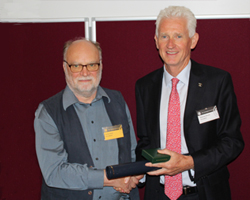 We now come to the Society’s two Coke medals, awarded to geoscientists who have made a significant scientific contribution and been of significant service to geology through activities of benefit to the community.
We now come to the Society’s two Coke medals, awarded to geoscientists who have made a significant scientific contribution and been of significant service to geology through activities of benefit to the community.
The first goes to Professor Ian Fairchild of the University of Birmingham.
Ian Fairchild is a highly respected, internationally renowned scientist within the Earth science community, for his wide-ranging work on the geochemistry of the Earth’s surface, climate change, and Quaternary and Neoproterozoic Earth history. He is an authority on carbonates and has interests that span the entire geological record. He has an outstanding record of service to the community through teaching, in public outreach, and professional activities such as examining and research assessment.
Ian has published extensively, and is highly cited across all these areas, with a Google Scholar h-index of 51. His research on geochemical processes associated with modern glaciers and caves began in 1990, has encompassed experimental work, and complements a longer-standing interest in carbonates and ice ages in deep time. He has a particularly strong reputation in carbonate systems – co-authoring the definitive text on calcareous cave deposits or ‘speleothems’, and their use in determining past climates, and making notable contributions to the debate over the ‘Snowball Earth’ hypothesis.
Ian is respected for the quality of his work in the field, including the high-Arctic (Svalbard and Northeast Greenland), as much as in the laboratory. He complements his research excellence with a distinguished record of service to the wider geological community, including serving as Department Head at Keele and at Birmingham and as Dean of Science at Keele. A Chartered Geologist, he served as Chief Editor of the Journal of the Geological Society from 1996 to 2000, and an Editor of Reviews of Geophysics from 2005 to 2010. He has an extensive record of service to NERC and was a member of the sub-panel for Earth Systems and Environmental Sciences in the Research Excellence Framework, 2014.
Ian Fairchild, these achievements underline the breadth and depth of your service to geoscience and the community, rendering you a worthy recipient of the Coke Medal of The Geological Society of London.
Prof. Ian Fairchild replied:
Have you ever searched for yourself on Google? I found a former student posted about an imitation of a graptolite that I had made on a field trip. They found it memorable. I had forgotten it. Anyway how you would imitate a small colonial organism floating in the ocean? And looking back at papers written long ago, I marvel at what I knew then and know no longer.
I have spread my allegiances widely, joining over 12 different scientific societies across geology, geomorphology, hydrology and climate science, but it is with this Society that I have the greatest range of warm memories. I have often come along to the President’s Day – a grand day out, often with a free lunch when someone I have nominated has received an award! l am privileged in many ways through my fantastic family, and collegial colleagues and collaborators. What a career that has on occasion allowed me to work the night shift, for example creating ice at 1 mm/hour, filtering glacial meltwater or scanning a stalagmite, micron by micron, for its trace element content. What a career that has given me opportunities to travel the world above and below ground, and to feed back that learning enthusiastically to generations of students.
I marvel not so much at knowledge lost, but of the explosion in our understanding of the Earth over these past 40 years. Partly motivated by the concept of Earth System Science, the most serious thing I have tried to do is to bridge geology scientifically and administratively with cognate disciplines. I am one of those working to establish that a new Anthropocene geological epoch is justifiable based on tangible records in physical archives. Thus the full horror of human impact on the Earth’s surface is laid bare. We are not rulers of this planet, but we are responsible for its future.
Dr Mark Anderson (Coke Medal)
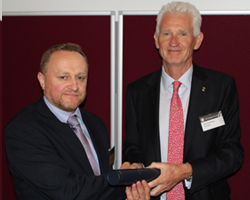 The second of the Society’s Coke medals is awarded to Dr Mark Anderson of Plymouth University.
The second of the Society’s Coke medals is awarded to Dr Mark Anderson of Plymouth University.
Mark Anderson has made substantial and internationally recognised contributions to geology through his research on the tectonic evolution of Palaeozoic and Alpine orogens in NW Europe. His work integrates field-based structural geology and laboratory-based analytical research, with collaborators across a range of sub-disciplines – perhaps most notably palaeomagnetism. A committed advocate of field-teaching in geology, Mark was also project leader for fieldwork within the Centre for Excellence in Teaching and Learning (Experiential Learning in the Environmental and Natural Sciences) based in Plymouth.
Mark’s combination of academic and practical knowledge has resulted in significant benefit to the global geological community - most recently in his involvement with the Committee of Heads of University Geoscience Departments, and he has been instrumental in setting up its successor body, University Geoscience UK. Mark has served the whole of the UK geoscience community with aplomb as Executive Secretary for both, and as a Committee member of the Geological Society Higher Education Network since 2011.
His understated, inclusive approach has provided the essential ‘glue’ between these groups and the wider geoscience community. This he did while developing and running the Plymouth Earth Sciences department, which has grown substantially under his leadership.
He has shown enthusiastic commitment to retaining geology as a viable school subject at both GCSE and ‘A’ level, ensuring the supply of candidates for Higher Education. He was directly involved in establishing the new DfE geology criteria that enabled the subject to be successfully considered for inclusion in the revised science curriculum, and his academic support for the people charged with writing the new specifications was invaluable.
Mark has been a Committee member, Deputy Chair and Chair of this Society’s South West Regional Group, and Chair of the Ussher Society.
Mark Anderson, these many contributions render you a worthy recipient of the Coke Medal of The Geological Society of London.
Mark Anderson replied:
Mr President, Fellows, Ladies and Gentlemen, I am deeply honoured to receive a Coke medal, and humbled to join a distinguished list of past recipients.
In common with many, my geological career was ignited during my A-levels by a couple of subversive geology graduates masquerading as geography teachers. I proceeded to graduate from Southampton University with a BSc in Geology in 1985, where a rich programme of fieldwork and inspirational teaching by the likes of Andy Barker and Jim Andrews convinced me to continue on to a PhD at Cardiff. Under the joint supervision of Rod Gayer and Andy I spent almost eight months mapping several hundred square kilometres of Caledonian thrust sheets in Arctic Norway – fostering a fascination with mountain building processes, and a love for Scandinavia, that persists to the present day.
Through these formative years I gained a deep appreciation of the value of field-based teaching and research, something which continues to underpin my academic career almost thirty years on. I have been fortunate that my enthusiasm for fieldwork has been shared with many like-minded colleagues too numerous to name, but especially both the staff and students at Plymouth University. It is perhaps unwise then to single out particular individuals, but Matthew Watkinson stands out on the teaching side alongside Tony Morris and David Peacock through numerous research collaborations. To these names I should add those of my wife, Cristina, and our daughters Rebecca and Charlotte for tolerating frequent absences for fieldwork and constant ramblings on geology when home.
Finally, the citation refers to the “essential glue” between various strands of the geoscience community. Together with Mike Lovell and the late Jon Davidson, both past Chairs of CHUGD, we recognised a need to reconnect University departments with the wider supply chain for professional geoscientists, from schools through into industry and academia. We can see the full extent of that chain represented at this Awards Ceremony today and I thank the Society sincerely for this recognition, which I accept with pleasure.
Professor John Walsh (William Smith Medal)
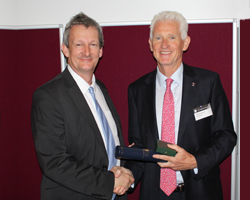 The medal named for William Smith celebrates outstanding achievement in the field of applied geology, and this year we are delighted to present it to Professor John Walsh of University College, Dublin.
The medal named for William Smith celebrates outstanding achievement in the field of applied geology, and this year we are delighted to present it to Professor John Walsh of University College, Dublin.
The medal named for William Smith celebrates outstanding achievement in the field of applied geology, and this year we are delighted to present it to Professor John Walsh of University College, Dublin.
Together with the late Juan Watterson, John Walsh founded the Fault Analysis Group at Liverpool University in the mid-1980s, establishing a new discipline of quantitative fault analysis, now employed in the mining and petroleum industries. He helped pioneer the understanding of the growth and kinematic analysis of faults and their impact on fluid flow. He is now Director of iCRAG, (the Irish Centre for Research in Applied Geosciences) a major research initiative for resource geology in Ireland, co-supervising over 15 research students and post-docs, leading industry-funded projects and championing modern structural geology on editorial boards and professional bodies.
John’s work transformed the way geologists view the subsurface structure of fault systems, and as co-leader of the Fault Analysis Group for over 30 years, trained many highly skilled structural geologists for academe and industry. He changed the way we view static faulted structures, showing how their evolution through time can be reconstructed through careful measurement of their geometry and displacements. This work has proved fundamental to the study and risking of traps and fluid flow at basin and reservoir scales.
In over 150 papers (28 of which are citation classics), he has developed models for the geometry and growth of faults, showing how they can be analysed using seismic, field and mine plan data, and developing software that allows us to map and interpret them in the subsurface and account for the way they affect fluid flow.
A productive ambassador for academic relations with industry, he has forged close links with groundwater, mining and petroleum companies and undertaken over 100 related projects.
Combined with his considerable publishing record he has served on the editorial boards of the Bulletin of the GSA, Geology, Geological Journal, Journal of Structural Geology and Petroleum Geoscience. He has edited two Geological Society Special Publications.
John Walsh, it is my great pleasure to award you the William Smith Medal of The Geological Society of London.
John Walsh replied:
Mr President, I am very honoured to receive the William Smith Medal and I thank you and the Geological Society for this award.
William Smith demonstrated the importance of applied geoscience and geological mapping in the discovery of both fundamental and practical geological insights, and I am delighted to receive a medal bearing his name. Of course he is best known for his geological map, an achievement which transformed the geosciences 200 years ago.
Ever since, geoscientists like myself have benefitted from access to, and the production of, different forms of geological map, often underpinned by the acquisition of data and 3D models by industry and government - these datasets sustain many of us scientifically and for that we are very grateful. Since faults are both interesting and economically important, a happy coincidence indeed, my colleagues and I have been able to get support for our research over the past few decades and we thank our supporting funding bodies and industry.
Schemes which encourage the pursuit of research in all its forms, from the fundamental through to applied, are critical: as Juan Watterson, my colleague and friend, said in his response to receiving the Murchison medal in 2001, such schemes allow “researchers to pursue a 'bee-in-the-bonnet’, or an outlandish or an unpopular idea. Sometimes these ugly ducklings develop into the swans of our new orthodoxies. Sometimes they don't”. The same sentiments apply today.
I have been lucky to have the support of many people over the past few decades. My parents encouraged and supported all of their children to engage in both creative and scientific pursuits, giving us the time to find our way!
Padhraig Kennan my first lecturer, instilled in me the love of geology I have today. Paul Ryan encouraged my appreciation of fieldwork, mapping and looking at rocks! Juan Watterson showed me the importance of deeply thinking about scientific problems and the intellectual rewards that arise from that.
Thanks also to Conrad Childs and Tom Manzocchi my friends and colleagues, who are largely responsible for me receiving this award, as we have kept ourselves and other members of the Fault Analysis Group busy over the past few decades.
Finally, I want to particularly thank Annette and our 4 kids, who have put up with me, and my enthusiasm for geology, over the years!
Professor Tim Elliott (Murchison Medal)
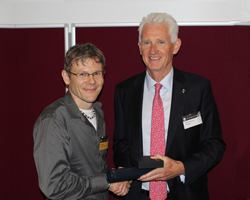 We bestow the medal named for Sir Roderick Impey Murchison on Professor Tim Elliott of the University of Bristol.
We bestow the medal named for Sir Roderick Impey Murchison on Professor Tim Elliott of the University of Bristol.
Tim Elliott is a geochemist whose research has been at the forefront in the development and application of radiogenic and stable isotope ratios. Most has been applied to understanding the composition and evolution of the mantle and of the melting processes in the mantle, but some has also proved important to palaeoclimate analysis.
His research has largely been based on state-of-the-art mass spectrometer facilities, and using novel isotopic systems. He has combined considerable analytical expertise with modelling the physics of processes controlling melt formation and movement in the mantle. The result has been a series of important papers dealing with first-order problems published in high profile journals.
This important work includes his 1991 Nature paper (with Elliott and others), which inferred melt-mixing from compositionally distinct sources - anticipating by nearly 15 years the recent important insights that small melt inclusions are throwing on melting and fractionation processes (in the Iceland plume, and elsewhere).
His work on Uranium-series isotope systems yielded key information on the timescales of melt formation and separation, and on the nature of the melting reactions. More recent work, using the light stable Lithium isotopes, has led to important conclusions about subduction zone processes and the nature of mantle heterogeneity.
The palaeoclimate record on Earth provides the prime evidence that atmospheric CO2 concentration matters. Boron-isotope analysis of foraminifera offers perhaps the best constraints on past oceanic pH, and in a paper with Rae and others (published in 2011) the authors perform stringent estimates of the uncertainties inherent in calculating pH using Boron-isotopic and Boron/Calcium data.
Tim Elliott, your publication record is diverse and characterised throughout by carefully thought-out and important papers on significant topics. This is the record of a leading scientist and you are indeed a worthy recipient of the Murchison Medal of The Geological Society, which it is my great pleasure to present to you now.
Tim Elliott replied:
Mr President, thank you for your kind words. I am greatly honoured to receive an award named after this splendidly christened scientist who defined a Period of Geological Time, not least, since I have long considered myself more of a failed chemist than a geologist. I will confess that it was not so much a love of rocks that brought me to discipline as my inability to deal effectively with the wave equation. However, my empathy with silicates has grown stronger with the years and I experienced an epiphany while teaching Igneous Geology. I will even claim to have undertaken some proper field of late, fittingly traversing the Murchison terrane of Western Australia. Still, be wary of the deluded isotope geochemist who tries to assert their importance outside the mass-spectrometry lab.
So onto terra firma, I stress that isotope geochemistry is far from a solitary activity. I have been supported by and learned from many talented researchers in the labs where I have worked, from the fabulous, final flourish of the eighties at the Open University, to the buzz of Lamont and the luxury life of Amsterdam. I had not foreseen returning to the UK to establish a new lab with my PhD supervisor, Chris Hawkesworth, but the move to Bristol worked out better than I could have imagined. In significant part, this was made possible by the heroic work of Geoff Nowell in helping us get off the ground and the mass-spectrometric genius of Chris Coath in propelling us forward. I feel very fortunate to have enjoyed a time in which plasma mass-spectrometry has opened up uncharted vistas of the chart of nuclides. I am grateful to all those who have taken the risk of working with me in this exploration and the denizens who have made the Bristol Isotope Group such a vibrant community over the last 18 years.
Professor Rosalind Rickaby (Lyell Medal)
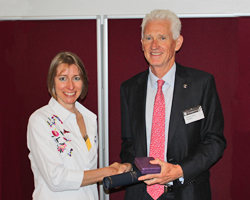 The medal named for one of the 19th Century’s most influential geologists, Sir Charles Lyell, goes this year to Professor Rosalind Rickaby of the University of Oxford.
The medal named for one of the 19th Century’s most influential geologists, Sir Charles Lyell, goes this year to Professor Rosalind Rickaby of the University of Oxford.
Ros Rickaby has made fundamental contributions to understanding the history of the ocean and, in particular, biogeochemical cycling through deep time. She has advanced our understanding of how biochemical processes govern the behaviour of isotopes and trace elements during biomineralisation, which is vital for using geochemical proxies in reconstructing past climate change.
She ‘thinks big’. Her research explores links between geology and biology, and how the long-term evolution of ocean chemistry has affected the Earth’s climate and biotic evolution. She has become a leader in the emerging field that is the co-evolution of the chemistry of the environment, and life.
Considering that Charles Lyell contributed significantly to Darwin's thinking on evolution, it is most fitting that Professor Rickaby has innovatively explored the links between the evolution of mineralising organisms, ocean chemistry, atmospheric composition, and climate. The chemical signatures contained within fossilised shells of marine micro-organisms are important proxies for constraining past ocean conditions and their influence on climate. Ros has made many seminal contributions to geochemical proxy development, by using a wide range of isotopes and trace metals.
By all the standard metrics of academic performance Professor Rickaby is highly accomplished, and last year she received a prestigious European Research Council (ERC) ‘consolidator’ grant entitled: ‘Optimizing Elements for Life: A Probe of the Periodic Elements for Life in the Sea’. In this project she will explore the whole Periodic Table for novel elements required by phytoplankton, and how the biological pump of carbon is related to ocean chemistry in an evolving world. The ERC award assures that there is more highly innovative work yet to come from Professor Rickaby’s research group.
Ros Rickaby, it is my great pleasure to award you now the Lyell Medal of The Geological Society of London.
Ros Rickaby replied:
President, honoured guests, Fellows of the Society:
Thank you so much for your kind words. I was literally gobsmacked on learning I was to be awarded the Lyell Medal of the London Geological Society, feeling utterly unworthy of such an honour. A mere glance at previous awardees includes such an array of my scientific heroes. I cannot believe I deserve a place amongst them but I am enormously grateful to those who nominated me, and the Society.
It was on a second year undergraduate fieldtrip in the beauty of Lulworth cove that the imaginative world of geology won me over.
The Wealden outcrop there shows that “submergence of an ancient continent, however fabulous in history, may be true as a geological event”. Lyell’s stratigraphic context and slow tempo to Earth history allowed Darwin’s theory of natural selection to unfold. I too have explored how changing environmental chemistry, itself a consequence of life, could add context to evolution. This was together with the unrivalled bioinorganic chemist, the late Bob Williams, at times over a slice of cake, and with one or two of my squawking babies in tow. As life perturbs our planetary chemistry again, it is ever more urgent that we chart and preserve the dimensions of our current ecosystem’s habitable niche.
My past has been the key to my present. There are so many to whom I am indebted for inspiring me, opening new scientific vistas and believing in me. I was so lucky to start out in the palaeoceanographic powerhouse in Cambridge with the brilliant triumvirate of Nick Shackleton, Nick McCave and Harry Elderfield. I will never thank Harry enough. He gave me such a broad horizon that I continue to work on threads of my PhD. Dan Schrag opened my mind to deeper time. The Oxford faculty, and all the incredibly gifted PhD students and post-docs, have been incredibly tolerant of my increasing entropy. Thanks to my Mum, simply the best Mum, and my two gorgeous, if boisterous, boys for adding a rich new context to my life.
Professor Richard Alley (Wollaston Medal)
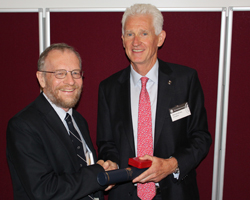 Finally, we come to the Wollaston Medal – the Society’s senior medal and highest accolade, first awarded to William Smith in 1831. Today this most prestigious accolade goes to Professor Richard Alley of Pennsylvania State University.
Finally, we come to the Wollaston Medal – the Society’s senior medal and highest accolade, first awarded to William Smith in 1831. Today this most prestigious accolade goes to Professor Richard Alley of Pennsylvania State University.
Richard Alley is one of the outstanding Earth scientists of his generation. His research focuses on ice sheets, glacial and glacial-geological processes, and ice-core records of climate change. His work has demonstrated the amplitude of abrupt climate change and natural variability of the Earth’s climate system, and he has contributed fundamental advances in our understanding of ice-bed processes and their impact on ice-stream flow, with implications for ice-sheet collapse and global sea level.
His award-winning book: The Two-Mile Time Machine: Ice Cores, Abrupt Climate Change, and Our Future (Princeton University Press) published in 2000, marks him as a superb communicator.
Richard Alley’s research on ice sheets encompasses fundamental process investigations, interpreting the ice-core record of climate change, correlations between the Antarctic and Greenland ice-core records, and the implications of ice-sheet behaviour on the wider Earth system.
His early work was fundamental in developing our understanding of the way a deformable layer of till beneath ice sheets promotes rapid ice-flow, and thereby controls the courses of major streams draining ice sheets - now recognised as a key element in ice-sheet instability. He was responsible for the key papers defining the 8.2-thousand-year climate event – documented from the ice core records – and on the millennial-scale climate variability that characterised the last ice age. He has been central in correlating the Greenland and Antarctic ice-core records, revealing the abrupt climate-change anti-phasing between the two hemispheres that led to the ‘bipolar seesaw’ hypothesis.
He has contributed influential papers on the glaciological origins of Heinrich events - episodes of major ice-sheet collapse during the last ice age. He contributes regularly to the very best journals; his research output is highly cited and he currently has an h-index of 70 with over 18,000 citations.
Richard Alley is also an outstanding science communicator. His book, The Two-Mile Time Machine, won the Phi Beta Kappa Science book award and the 2001 Choice Award, and he has authored five other award-winning popular texts. He is one of the most active voices translating Earth sciences for the media.
He took part in the Nobel Peace Prize-winning IPCC process on climate change, being lead author of the Cryosphere chapter and a member of the writing team that produced the Summary for Policymakers and Technical Summary for Working Group 1 of the Fourth Assessment. This followed participation in the Second and Third Assessments.
He has given invited presentations and testimony to US Government officials in many administrations, including the US Vice-President, the President’s Science Advisor, two Senate and five House Committees, various senators and representatives, as well as travelling to Greenland, as a speaker and expert, with 10% of the US Senate.
Richard Alley, you have dominated research into the dynamics of Earth’s cryosphere, and your work is of major environmental - and hence, public policy importance. You are a profoundly important figure in science today. It therefore gives me the greatest pleasure to acknowledge your outstanding achievements by conferring upon you now the Wollaston Medal of The Geological Society of London.
Richard Alley replied:
With deep humility, I thank you for this great honour. The earlier recipients of the Wollaston Medal became my heroes when I was a geology student, and more-recent medallists are valued and respected colleagues. I never imagined my name on that list.
Since you saw fit to add me, I would like to highlight the value of what you do. We surely live in “interesting” times. A cellular telephone, which uses relativistic calculations in the GPS and quantum-mechanical design in the computer, is assembled from petroleum-based plastics as well as precious metals and rare earth elements discovered by Earth scientists. Many of our fellow citizens recognize this, with polls showing generally high respect for scientists. Yet, apparently without irony, others of our neighbors and elected leaders use their cellular scientific-engineering triumphs to cast doubt on the very science that makes them possible.
Before the end of the ice age with its abrupt climate jumps, human predation combined with climate stress to drive megafaunal extinction, lowering the food supply for out hunter-gatherer ancestors. In some sense the Earth was overpopulated, at a time when the human population may have been as small as a few million. But by learning better ways to discover and teach, to grow and build, to clean up after themselves and get along with their neighbours, our “overpopulated” ancestors then doubled and redoubled their population, through about 10 doublings to reach our modern billions. Projections suggest that we might achieve a sustainable civilization over the next century with just one more doubling of the good things we get from the planet.
Worded that way, the task sounds almost easy. Framed differently, however we must achieve as much in a human lifetime as in all of prior written history. Some of our students despair at that challenge, fearing that the task is beyond us. But, compare Charles Darwin’s questions about inheritance to our modern abilities in genetics and medicine, or fast-forward from Henry Clifton Sorby studying the structures of minerals and steels to the exquisite materials-science control that enables the computer chips in cell phones. Given recent progress and the commitment of the many students who are rising to the challenge, we really can solve problems and advance well-being.
The necessary solutions will draw heavily on the work of those medallists who have stood here before me, and on the full range of sciences and engineering. And increasingly, the solutions must draw not only on our ability to learn, build and grow, but also to engage the support of all people in this effort, even those who are now using their cell phones to disparage science. I hope I can play a small part, and I thank you for including me in this great adventure.
Save
Save
Save
Save